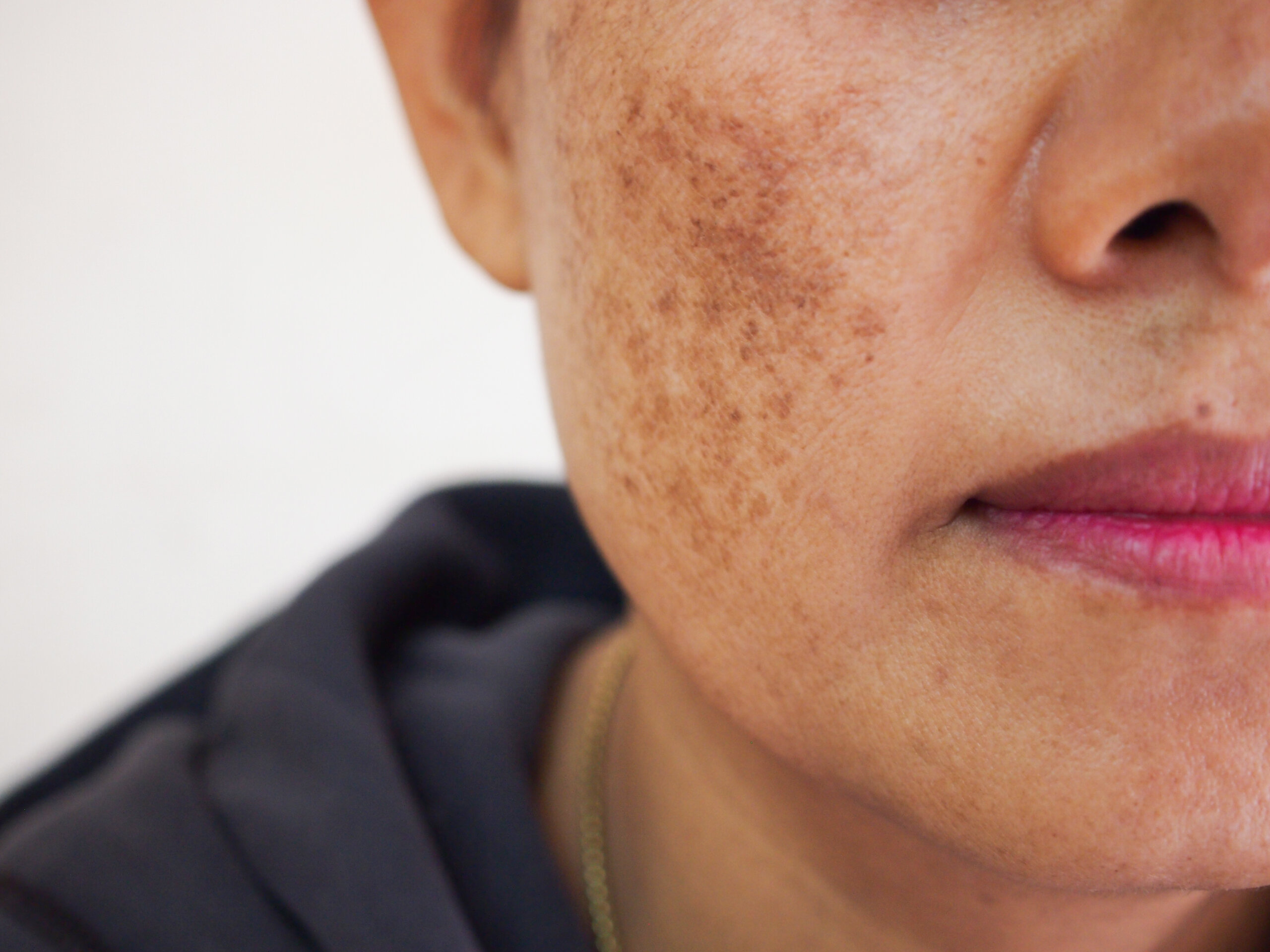Melasma is a common form of hyperpigmentation, skin darkening, that can develop on any part of the body, but it’s most common on the face. It causes darker spots or patches of skin, and while anyone can develop melasma, it’s most common in women, especially expectant mothers. According to Dr. Jennifer Holman of U.S. Dermatology Partners in Tyler, Texas “The bad news about melasma is how common it is, especially during pregnancy. The good news is there are many effective ways to treat melasma, and while this condition can leave skin looking less than perfect, it’s not a harmful or dangerous condition.” In this blog, Dr. Holman dives deep into the symptoms and causes of melasma as well as exploring top recommended melasma treatments.
Symptoms of Melasma
The most common melasma symptoms are brown or gray brown spots. Melasma patches are usually only slightly darker than the natural skin tone. Some people develop small spots that resemble freckles. Others have larger patches of skin impacted by melasma. The smaller spots and patches can also combine to cover larger areas of skin. While melasma can develop on any part of the body, it’s most common in the following areas:
- Forehead
- Nose
- Cheeks
- Above the lip
- Chin
Causes of Melasma
There is not one underlying cause of melasma, but there are many factors that contribute to this condition. Melasma happens when skin’s pigment-producing cells, melanocytes, are more active and develop in higher numbers. Melasma occurs when something triggers the overproduction of melanocytes. Melasma causes and triggers vary, but some of the most common melasma triggers include:
- Hormones – pregnancy-related hormonal fluctuations as well as increases in estrogen or progesterone during puberty, while taking hormonal birth control, during menopause, or at other times can trigger melanocyte production, leading to melasma. Cortisol, the stress hormone, is also linked to increased risk for melasma. Finally, thyroid disease changes how a variety of hormones are produced, which can contribute to the development of melasma.
- UV damage – sunlight, tanning beds, and other sources of ultraviolet radiation contribute to melanin production, increasing risk for melasma.
- Melanocyte Stimulating Hormone (MSH) – this hormone is produced naturally, and it determines skin tone. When sunlight and other sources stimulate an overproduction of MSH, melasma can occur. Because of this, getting UV exposure on parts of the body that don’t have melasma spots can still worsen melasma.
- Medications – anti-seizure medicines and hormonal birth controls are the most common medicines that increase risk for melasma, but there are other medicines that have been linked to this skin condition. Make sure to review all medications with your dermatologist. Additionally, medications that may cause sun sensitivity, like antibiotics and some blood pressure medicines, may increase risk for melasma development.
- Stress – cortisol is a hormone produced due to stress. It is linked with inflammation and a range of skin and whole-body health concerns, including a greater risk for developing melasma.
- Thyroid disease – the thyroid produces and regulates hormones that are integral a variety of bodily functions. Slow thyroid function (hypothyroidism) can increase estrogen levels, which mimics pregnancy and can cause the production of melasma spots.
- Heat – heat may not necessarily cause melasma to develop, but it can make melasma worse, causing spots to darken or spread.
Melasma: Diagnosis and Treatment
When it comes to diagnosing melasma, Dr. Holman says, “In almost all cases, I’m able to diagnose melasma with a careful visual examination. When in doubt, I may use a microscopic viewing tool or perform a skin biopsy. However, this is only necessary in cases where melasma mimics other skin conditions, so it’s unclear whether I’m looking at melasma or a similar pigmentation disorder.”
For those whose melasma is hormonal, managing hormones can resolve the condition. Some will have just one or two melasma flareups over a year or a few before melasma resolves on its own, but others will experience flareups in melasma throughout their lives. Melasma isn’t harmful, and it doesn’t require treatment. However, you can choose to treat melasma. Treatment of melasma is usually geared toward decreasing pigment production and creating a more even skin tone. A dermatologist can help you develop a skincare routine and treatment plan to improve the appearance of melasma, including:
- Sunscreen – one of the most important things you can do to keep skin free of melasma is to apply a broad-spectrum sunscreen with an SPF of 30 or higher every day.
- Topical lightening creams – hydroquinone has been the go-to topical ingredient to improve the appearance of melasma for many years, but as we begin to understand the potentially adverse effects of long-term hydroquinone use, dermatologists are more likely to recommend non-hydroquinone skin-lightening treatments like SkinCeuticals Discoloration Defense. If you’re looking for non-hydroquinone skin-lightening products to address melasma, check for ingredients like cysteamine, tranexamic acid, kojic acid, azelaic acid.
- Retinols – retinols and prescription retinoids may be recommended to remove dead skin cells, promote cell turnover, and reveal healthier skin with an even tone and texture.
Even with an effective skincare routine, melasma will take time to respond to treatment, so it’s important to be patient and consistent. To improve the efficacy and speed of treatment results, you may want to include a dermatologic treatment like a chemical peel, microneedling, laser or light treatment, which will be described in greater detail below.
Chemical Peels
Chemical peels remove the outer layers of skin to reveal healthier new skin cells below. This treatment uses chemicals to dissolve damaged and discolored skin cells. This jumpstarts the healing process and promotes collagen and elastin production. This can remove skin cells that have excess pigmentation and encourage the production of cells that match the natural skin tone. Chemical peels are quick, gentle, and effective treatments that improve skin’s tone and appearance.
Microneedling
The innovative microneedling procedure uses ultra-fine gauge needles to create micro injuries to the skin. While it may seem counterintuitive to damage skin when you’re trying to heal it, microneedling triggers your body’s natural healing response, which can often diminish the appearance of melasma. Additionally, microneedling improves skin’s tone and texture as well as providing anti-aging benefits by reducing the appearance of fine lines and wrinkles.
Laser and Light Treatments
Laser and light treatment can be used to target and remove pigment-producing cells within melasma patches. By targeting and removing the damaged cells, laser treatment offers a highly precise way of improving the appearance of melasma. It’s essential to work with a skilled professional to receive laser or light treatment for melasma. Improperly performed laser treatment can actually trigger or worsen melasma.
Choosing the Right Treatment for You
When it comes to finding the right treatment option, Dr. Holman says, “I may be biased, but my number one recommendation is always to start by talking to your dermatologist. They understand your skin’s overall needs, so they can guide you to the right products and treatments to reduce the appearance of melasma without causing irritation or other skin health concerns. In general, keep your skin type in mind when choosing a melasma treatment. If you have sensitive skin, a plan that uses numerous harsh, abrasive ingredients or treatments may not be the right option. Those with acne-prone skin may not want to apply heavy skin-lightening creams that could increase risk for clogged pores. Always start treatments slowly and give them plenty of time to work. Apply a small amount of a product to one area for at least a week. Pay attention to any potentially harmful symptoms and discontinue use of a product right away. If you’re concerned that a treatment isn’t working, make sure you’ve given it at least two weeks of consistent daily care to give the product time to work.”
Safely & Effectively Improve the Appearance of Melasma
According to Dr. Holman, “There are numerous treatments that improve the appearance of melasma and leave patients looking and feeling their best. Whether you have one or two melasma spots or large areas of skin covered with melasma patches, a dermatologist can help you understand this condition and develop an effect plan to create an even skin tone and improve overall skin appearance.”
Schedule a Melasma Treatment Consultation
If you’re interested in exploring treatment options for melasma with a trusted professional, the U.S. Dermatology Partners team would love to hear from you. Fill out our quick online scheduling request form to get in touch with one of our local practices. Once we receive your request, we’ll be in touch to finalize the details of your upcoming visit.
Find a location near me
or


